Introduction
In the battle against dust and air pollution, air purifiers have emerged as a powerful weapon. But how do you ensure that your air purifier is effectively capturing dust and other harmful pollutants? Dust testing provides an invaluable solution, allowing you to assess the performance of your air purifier and make informed decisions about your indoor air quality.

The Importance of Air Purifier and Dust Testing
According to the Environmental Protection Agency (EPA), indoor air can be up to five times more polluted than outdoor air. Dust, a major contributor to indoor air pollution, contains a myriad of harmful substances, including allergens, bacteria, viruses, and chemicals.
Exposure to these pollutants can lead to a range of health issues, including respiratory problems, allergies, and asthma. Dust testing can help identify and quantify these pollutants, enabling you to take proactive steps to improve your indoor air quality.
How to Test for Dust
There are several methods available for testing the dust levels in your home or office.
- Air Sampler with HEPA Filter: An air sampler draws air through a HEPA filter, trapping dust particles. The filter is then analyzed to determine the concentration of dust in the air.
- Tape Lift Method: This method involves lifting dust from surfaces using adhesive tape. The tape is then analyzed under a microscope to identify and count dust particles.
- Dust Mite Test Kit: This kit measures the presence of dust mites, which are common allergens found in dust.
Comparing Air Purifier and Dust Testing
Benefits of Air Purifiers
- Reduce Dust Levels: Air purifiers with HEPA filters can effectively trap and remove dust particles from the air.
- Improve Indoor Air Quality: Air purifiers can remove a wide range of indoor air pollutants, including dust, pollen, smoke, and pet dander.
- Reduce Allergy Symptoms: By reducing dust levels, air purifiers can help alleviate allergy symptoms such as sneezing, runny nose, and watery eyes.
Drawbacks of Air Purifiers
- Cost: Air purifiers can be expensive to purchase and maintain.
- Noise: Some air purifiers can be noisy when operating.
- Maintenance: Air purifier filters need to be replaced regularly to maintain optimal performance.
Benefits of Dust Testing
- Identify Dust Sources: Dust testing can help you identify the sources of dust in your home or office, allowing you to take targeted steps to reduce dust levels.
- Assess Air Purifier Performance: By measuring dust levels before and after using an air purifier, you can evaluate the effectiveness of the purifier in removing dust from the air.
- Monitor Air Quality: Regular dust testing can help you monitor your indoor air quality over time and identify any changes that may indicate a need for additional air purification measures.
Drawbacks of Dust Testing
- Cost: Dust testing can be time-consuming and expensive, especially if multiple samples are taken.
- Inaccuracy: Dust testing results can be affected by factors such as sampling location and air flow.
- Limited Scope: Dust testing only provides information about dust levels, not other air pollutants.
Tips and Tricks for Effective Air Purifier and Dust Testing
- Choose the Right Air Purifier: Select an air purifier with a HEPA filter and a Clean Air Delivery Rate (CADR) that is appropriate for the size of your room.
- Place the Air Purifier Strategically: Position the air purifier in a central location where it can circulate air effectively.
- Run the Air Purifier Consistently: Air purifiers should be run continuously to ensure optimal performance.
- Clean the Air Purifier Regularly: Replace the air purifier filter as recommended by the manufacturer to maintain its efficiency.
- Dust Frequently: Regular dusting can help reduce dust levels and prevent it from accumulating on surfaces.
Conclusion
Air purifiers and dust testing are valuable tools for improving indoor air quality and reducing exposure to harmful pollutants. By combining these two methods, you can gain a comprehensive understanding of your indoor air environment and take proactive steps to create a healthier and more comfortable living space.
As technology continues to advance in 2025 and beyond, we can expect to see even more innovative air purifiers and dust testing methods that will further enhance our abilities to monitor and improve indoor air quality.





















